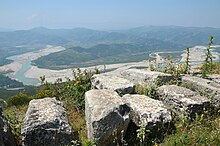

The Bylliones were an Illyrian tribe that lived near the Adriatic coast of southern Illyria (modern Albania), on the lower valley of the Vjosa river, in the hinterland of Apollonia.[1] The Bylliones were firstly attested in epigraphic material from the oracle of Dodona dating back to the 4th century BC, and their koinon was firstly attested in a 3rd-century BC inscription from the same oracle.[2] Their territory was trapezoidal on the right side of the rivers Luftinje and Vjosa, extending in the west to the Mallakastra mountains.[3] The chief city of their koinon was Byllis. Another important centre of their koinon was Klos, an earlier Illyrian settlement later called Nikaia, as an inscription attests.[4] The Bylliones also inhabited in the area of an ancient sanctuary of the eternal fire called Nymphaion.[5]
Through contact with their Greek neighbours, in Hellenistic times the Bylliones acquired a certain degree of Hellenization and bilingualism, especially in the urban centres of their koinon.[6][7][8][9] In Hellenistic times their koinon minted coins as attested by inscriptions reporting their ethnicon in Greek letters.[10] The koinon of the Bylliones survived until Roman Imperial times.[11] In the Roman era, the Bylliones reappear in the late 1st century CE when they are mentioned by Pliny the Elder in the Natural History (c. 79 CE) as one of the "barbarian" tribes which lived in the area of Nymphaeum.[12][13] The koinon of the Bylliones and the koinon of the Amantes were the most notable Illyrian koina.[14]
- ^ Ceka 2012, pp. 59–60.
- ^ Ceka & Ceka 2018, p. 977.
- ^ Hansen & Nielsen 2004, p. 343.
- ^ Ceka & Ceka 2018, p. 977; Hansen & Nielsen 2004, p. 346; Lippert & Matzinger 2021, pp. 101–102.
- ^ Bejko et al. 2015, p. 4.
- ^ Cite error: The named reference
Šašel_Koswas invoked but never defined (see the help page). - ^ Ceka 2022, p. 840: "...un’iscrizione della seconda metà del III sec. a.C. (Figs. 3; 3.1), che mette in evidenza l’esistenza di un esercito di guardie di frontiera, i peripoloi, comandati dal peripolarchos e assistiti da un grammateus... Tutti i nomi sono illirici e danno testimonianza di un’amministrazione composta da membri della communità indigena in una fase ancora iniziale del processo di acculturazione." p. 841: "Nelle iscrizioni amministrative dei Bylliones del III-II sec. a.C., si nota ancora la persistenza dell’onomastica illirica, nel nome e nel patronimico dei pritani... Per il resto si vede un’interferenza di nomi di origine apolloniata, che mostrano il progresso nel processo di acculturazione della popolazione locale." p. 839: "In un altro sito (...) lo scrittore considera ancora barbari i popoli Amantes et Buliones."
- ^ Winnifrith 2002, p. 58; Stocker 2009, p. 213; Hammond 1992, pp. 36–37.
- ^ Hammond 1994, p. 250: "It is likely that the Illyrian Bylliones adopted the terminology from the Greeks , for they became very thoroughly Hellenized during the fifty or so years of the rule of the Molossian kings ca . c . 290 – 240 B.C."
- ^ Lasagni 2019, p. 74; Stocker 2009, p. 213; Lippert & Matzinger 2021, p. 101.
- ^ Verčík et al. 2019, pp. 44–45.
- ^ Ceka 2022, p. 839.
- ^ Brodersen 2017, p. 91.
- ^ Shpuza 2022, p. 13: "Ainsi, il faut noter que l'Illyrie n'a jamais constitué un État unifié et centralisé40. L'organisation politique d'une partie des Illyriens était fondée sur le koinon. Les plus réputés d'entre eux étaient le Koinon des Bylliones et celui des Amantes, d'une organisation similaire à celle du Koinon des Épirotes. Parallèlement à ces koina, existait aussi un royaume illyrien, dont l'autorité s'exerçait sur une ou plusieurs tribus. Le royaume était plus solide dans la partie méridionale de Illyrie, où les rois sont attestés dès le siècle avant notre ère, même si leur dynastie ne peut être suivie qu'à partir du milieu du IIIe siècle avant notre ère."